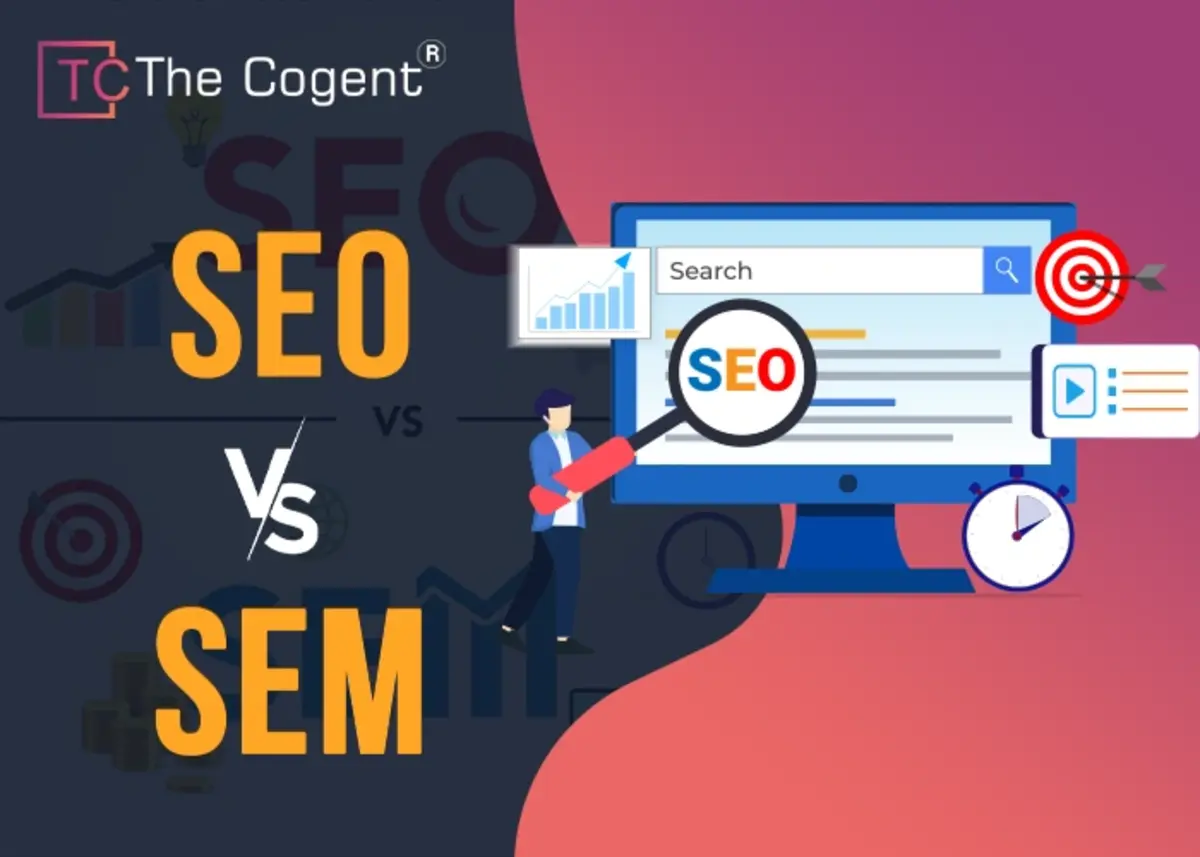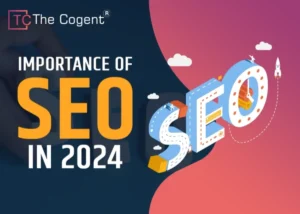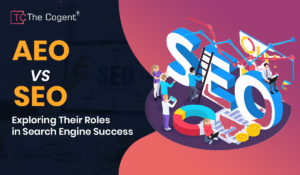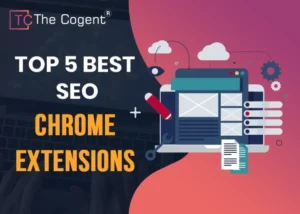SEO and SEM are two of the most important digital marketing strategies today. SEO stands for Search Engine Optimization, while SEM stands for Search Engine Marketing. Both of these methods are used to increase website traffic and improve website rankings on search engine results pages (SERPs). SEO and SEM are often used interchangeably, but they are actually two different techniques that serve different purposes. Understanding the differences between these two strategies is important to create an effective digital marketing plan that meets your specific goals.
Table of Contents
1. About Search Engine Optimization(SEO)
2. About Search Engine Marketing(SEM)
3. Difference Between SEO and SEM
4. Key Features of Search Engine Optimization(SEO)
- On-Page SEO
- Off-Page SEO
- Technical SEO
5. Key Features of Search Engine Marketing(SEM)
6. SEO vs. SEM: What is Best For Your Business?
7. SEO vs SEM: Cost Comparison
8. Conclusion
About Search Engine Optimization(SEO)
SEO is the process of optimising the website to improve its visibility as well as ranking on search engine results pages. SEO aims to increase organic (unpaid) traffic to a website by improving the website’s content and structure.
SEO involves both on-page and off-page optimization.
On-page SEO refers to the optimization of an individual web page to rank higher as well as earn more relevant traffic in search engines. Off-page SEO techniques refers to that can be used to improve the position of a website in the search engine results pages (SERPs). Some digital marketing company in Jaipur is highly focused on organic traffic through search engine optimization because it is a slow process and strong process.
About Search Engine Marketing(SEM)
SEM is a broader term that includes all paid marketing efforts that aim to improve a website’s visibility on search engines. SEM is often used to refer to paid search advertising, which is a form of online advertising that uses pay-per-click (PPC) ads to drive traffic to a website.
SEM can include other forms of paid advertising, such as display advertising, remarketing, and social media advertising. The main goal of SEM is to increase website visibility and generate more traffic through paid search ads. PPC Ads are also an important part of digital marketing and a PPC company in Jaipur specialised in SEM and helps to increase sales in compered to SEO.
Difference Between SEO and SEM
The key difference between SEO and SEM is that SEO focuses on organic traffic while SEM focuses on paid traffic. SEO is a long-term strategy that requires time and effort to achieve results, while SEM can provide quick results but requires ongoing investment.
Here is a table to summarise the differences between SEO and SEM:
| Bases | SEO | SEM |
| Traffic | Organic | Paid |
| Cost | No cost (except for time and effort) | Paid (pay-per-click or cost-per-click) |
| Results | Long-term | Short-term |
| Goal | Improve visibility and ranking. | Increase website traffic |
| Techniques | On-page and off-page optimization | Paid search advertising |
Key Features of Search Engine Optimization(SEO)
On-Page SEO
On-page SEO refers to the optimization of an individual web page to rank higher as well as earn more relevant traffic in search engines. On-page SEO includes optimising the content and structure of a web page to make it more search-engine friendly.
Some of the key on-page SEO techniques include:
Off-Page SEO
Off-page SEO techniques refers to that can be used to improve the position of a website in search engine results pages (SERPs) by external factors. Off-page SEO includes link building, social media marketing. and other techniques that can improve the reputation and authority of a website.
Some of the key off-page SEO techniques include:
- Link building – Acquiring high-quality backlinks from other websites to improve the authority as well as the credibility of your website.
- Social media marketing – Share your content on social media platforms and engage with your followers to increase brand awareness as well as drive traffic to your website.
- Influencer marketing – Collaborating with the influencers in your niche to promote your brand and drive traffic to your website.
- Online directory listings – Listing your business on online directories to improve your online presence and visibility.
- Guest posting – Write high-quality guest posts for other websites to build your brand authority and generate backlinks to your website.
Technical SEO
Technical SEO refers to the optimization of the technical aspects of the website to improve its visibility as well as ranking on search engine results pages. It includes optimising website speed, mobile responsiveness, website structure. and other technical aspects that affect the user experience and search engine crawling.
Some of the key technical SEO techniques include:
- Website speed optimization – Optimising website loading times to improve the user experience and also reduce bounce rates.
- Mobile responsiveness – Optimising website design for mobile devices to improve the user experience and meet Google’s mobile-first indexing criteria.
- Website structure optimization – Organizing website content and structure to make it easier for the search engines to crawl and index the website.
- Schema markup – Implementing schema markup on your website to help the search engines better understand the content and structure of your website.
- XML sitemap – Creating an XML sitemap to make it easier for the search engines to crawl and index your website.
Key Features of Search Engine Marketing(SEM)
- Bidding
Bidding is the process of determining how much you are willing to pay for each click on your ad. With SEM, you bid on specific keywords that you want to target. The higher you bid, the more likely your ad will appear in the top positions of search engine results pages (SERPs). However, the amount you bid on is not the only factor that determines your ad placement.
- Quality Score
Quality score is a metric that search engines use to evaluate the relevance and quality of your ad and landing page. It is calculated based on several factors, including the click-through rate (CTR) of your ad. The relevance of your ad to the search query, and the quality of your landing page. The higher your quality score, and more likely your ad will appear in the top positions of SERPs, even if you bid less than your competitors.
- Ad Copy
Ad copy is a text that appears in your ad. It is essential to create compelling and relevant ad copy that entices users to click on your ad. Your ad copy should include your target keyword, a clear call-to-action (CTA), and the benefits of your product or service. It is also essential to test different ad copy variations to see which ones perform best.
- Ad Groups and Account Management
Ad groups are a way to organise your ads into specific categories based on your target keywords. Each ad group should contain a set of closely related keywords and ad copy. Ad groups allow you to create highly targeted ads that are relevant to the user’s search query.
Effective account management is also crucial for SEM success. You should regularly monitor your campaign performance, adjust your bids and ad copy, and test new strategies to improve your ROI.
SEO vs. SEM: What is Best For Your Business?
SEO and SEM are both effective digital marketing strategies that can drive traffic and increase visibility for your business. so there are significant differences between the two.
SEO (search engine optimization) is the process of optimising your website to rank higher in organic search engine results pages (SERPs). SEO involves creating high-quality content, optimising your website’s technical aspects, and building backlinks to your site. Search engine marketing is a long-term strategy that takes time and effort to achieve results, but it can provide sustainable traffic and visibility over time.
SEM, on the other hand, is a paid advertising strategy that involves bidding on keywords to appear at the top of search engine results on pages. SEM can provide immediate traffic and visibility, but it requires a budget and ongoing management to maintain results.
The best strategy for your business depends on your goals, budget, and timeline. If you want to achieve immediate results and have a budget for paid advertising, SEM may be the best option. However, if you have a long-term view and want to build sustainable traffic and. visibility over time, SEO may be the better option.
SEO vs. SEM: Cost Comparison
One of the main differences between SEO and SEM is the cost. SEO is generally considered to be a more cost-effective strategy since it does not require ongoing payments for advertising. However, SEO requires significant time and effort to achieve results, and there are additional costs associated with creating high-quality content, building backlinks, and optimising your website’s technical aspects.
SEM, on the other hand, is a paid advertising strategy that requires a budget. The cost of SEM depends on several factors. including the competition for your target keywords, the bidding strategy. and the quality score of your ads. SEM can be more expensive than SEO, especially for highly competitive keywords in digital marketing. It can also provide immediate results and a higher ROI if managed effectively.
To determine which strategy is more cost-effective for your business, you should consider your budget, goals, and timeline. If you have a limited budget and a long-term view, SEO may be the better option. However, if you have a larger budget and want immediate results, SEM may be the better option.
Conclusion
SEM is a complex and highly competitive field that requires ongoing management and optimization to achieve success. The key features of SEM include bidding, quality score, ad copy, and account management. SEO and SEM are both effective digital marketing strategies that can drive traffic and. increase visibility for your business. but they have significant differences in cost and timeline.
The Cogent provides the best strategy for your business depends on your goals, budget, and timeline. If you have a long-term view and want sustainable traffic and visibility, SEO may be the better option. However, if you have a larger budget and want immediate results, SEM may be the better option.



